Assignment on Evolution of Medicine
VerifiedAdded on 2022/08/24
|9
|2324
|19
AI Summary
Contribute Materials
Your contribution can guide someone’s learning journey. Share your
documents today.
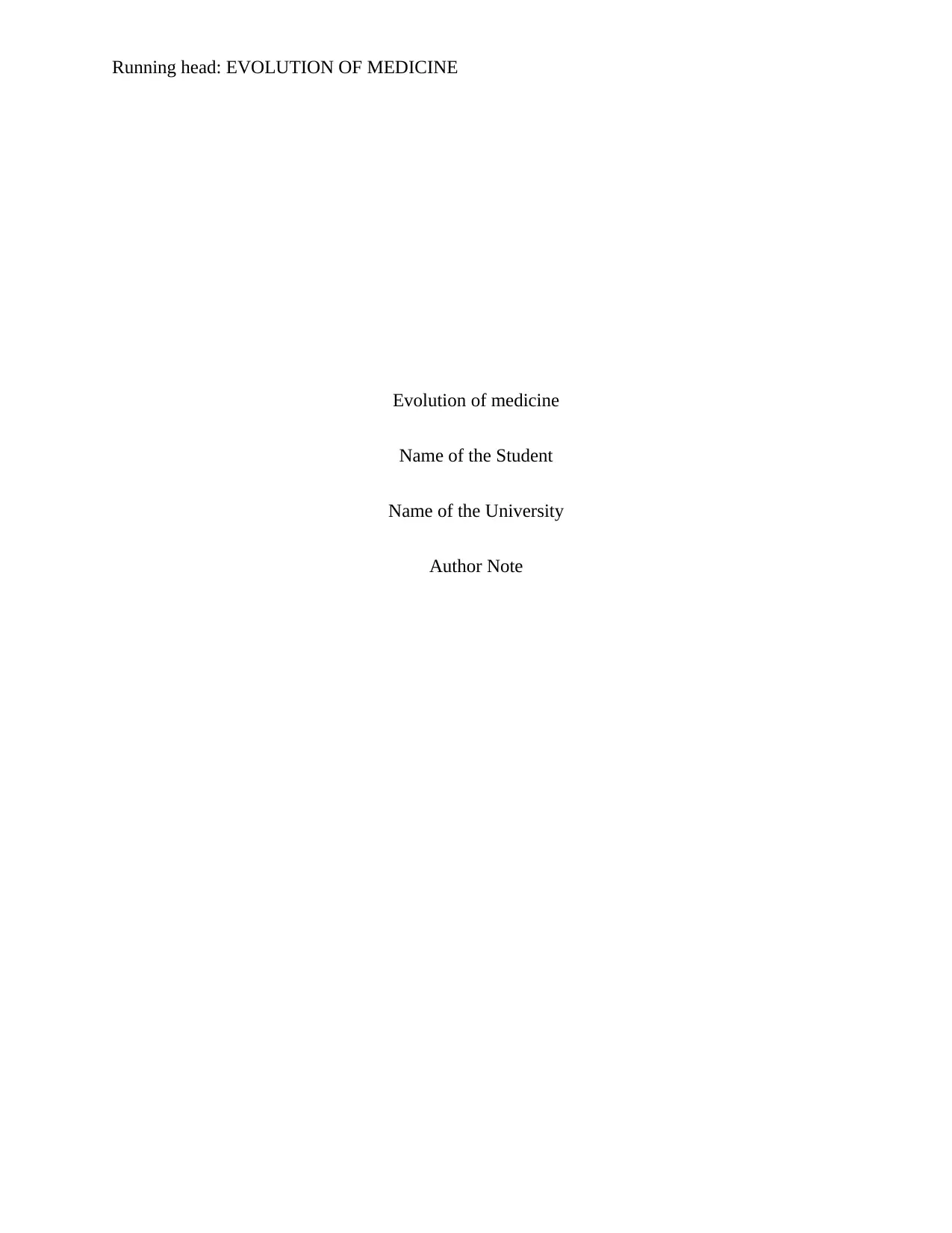
Running head: EVOLUTION OF MEDICINE
Evolution of medicine
Name of the Student
Name of the University
Author Note
Evolution of medicine
Name of the Student
Name of the University
Author Note
Secure Best Marks with AI Grader
Need help grading? Try our AI Grader for instant feedback on your assignments.
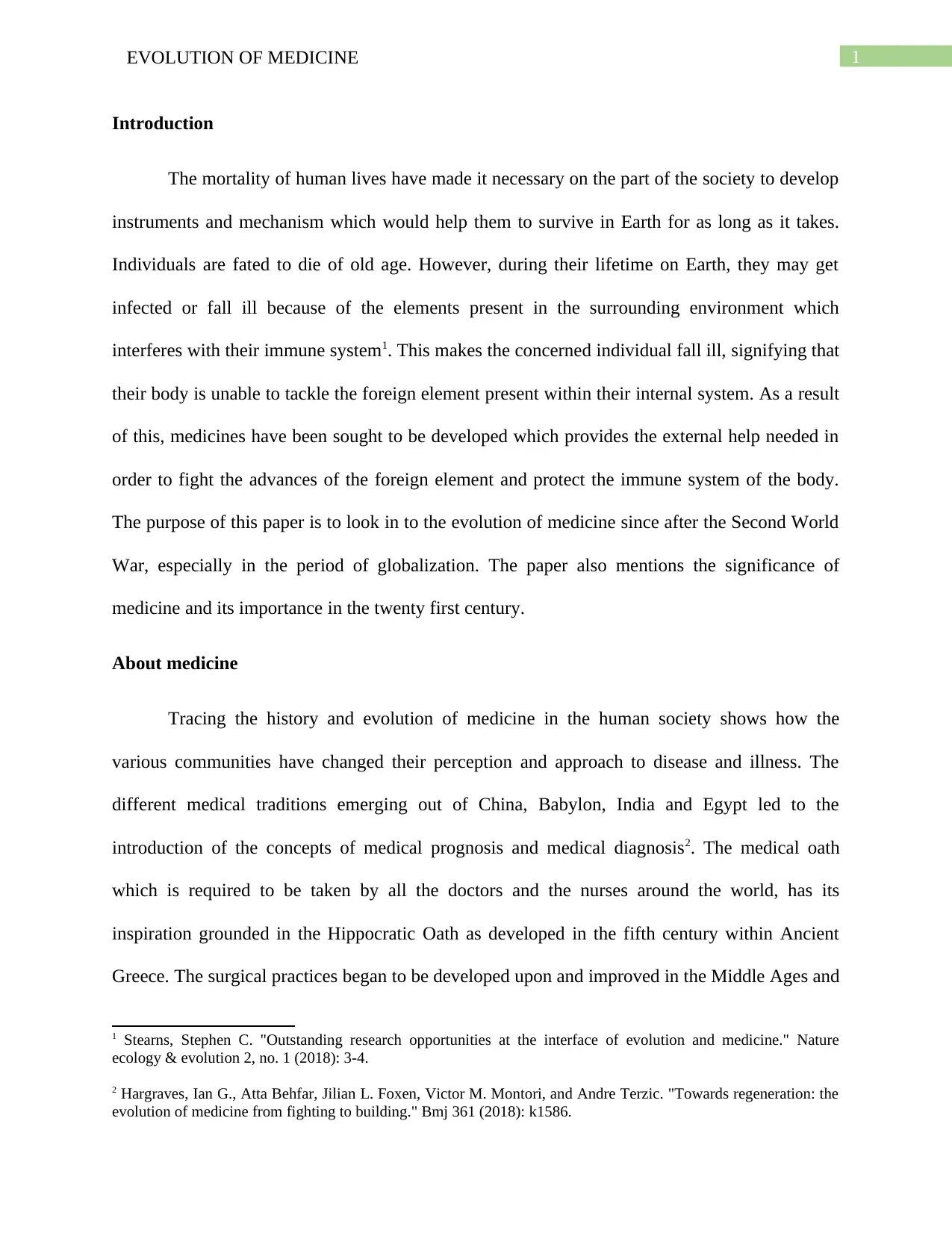
1EVOLUTION OF MEDICINE
Introduction
The mortality of human lives have made it necessary on the part of the society to develop
instruments and mechanism which would help them to survive in Earth for as long as it takes.
Individuals are fated to die of old age. However, during their lifetime on Earth, they may get
infected or fall ill because of the elements present in the surrounding environment which
interferes with their immune system1. This makes the concerned individual fall ill, signifying that
their body is unable to tackle the foreign element present within their internal system. As a result
of this, medicines have been sought to be developed which provides the external help needed in
order to fight the advances of the foreign element and protect the immune system of the body.
The purpose of this paper is to look in to the evolution of medicine since after the Second World
War, especially in the period of globalization. The paper also mentions the significance of
medicine and its importance in the twenty first century.
About medicine
Tracing the history and evolution of medicine in the human society shows how the
various communities have changed their perception and approach to disease and illness. The
different medical traditions emerging out of China, Babylon, India and Egypt led to the
introduction of the concepts of medical prognosis and medical diagnosis2. The medical oath
which is required to be taken by all the doctors and the nurses around the world, has its
inspiration grounded in the Hippocratic Oath as developed in the fifth century within Ancient
Greece. The surgical practices began to be developed upon and improved in the Middle Ages and
1 Stearns, Stephen C. "Outstanding research opportunities at the interface of evolution and medicine." Nature
ecology & evolution 2, no. 1 (2018): 3-4.
2 Hargraves, Ian G., Atta Behfar, Jilian L. Foxen, Victor M. Montori, and Andre Terzic. "Towards regeneration: the
evolution of medicine from fighting to building." Bmj 361 (2018): k1586.
Introduction
The mortality of human lives have made it necessary on the part of the society to develop
instruments and mechanism which would help them to survive in Earth for as long as it takes.
Individuals are fated to die of old age. However, during their lifetime on Earth, they may get
infected or fall ill because of the elements present in the surrounding environment which
interferes with their immune system1. This makes the concerned individual fall ill, signifying that
their body is unable to tackle the foreign element present within their internal system. As a result
of this, medicines have been sought to be developed which provides the external help needed in
order to fight the advances of the foreign element and protect the immune system of the body.
The purpose of this paper is to look in to the evolution of medicine since after the Second World
War, especially in the period of globalization. The paper also mentions the significance of
medicine and its importance in the twenty first century.
About medicine
Tracing the history and evolution of medicine in the human society shows how the
various communities have changed their perception and approach to disease and illness. The
different medical traditions emerging out of China, Babylon, India and Egypt led to the
introduction of the concepts of medical prognosis and medical diagnosis2. The medical oath
which is required to be taken by all the doctors and the nurses around the world, has its
inspiration grounded in the Hippocratic Oath as developed in the fifth century within Ancient
Greece. The surgical practices began to be developed upon and improved in the Middle Ages and
1 Stearns, Stephen C. "Outstanding research opportunities at the interface of evolution and medicine." Nature
ecology & evolution 2, no. 1 (2018): 3-4.
2 Hargraves, Ian G., Atta Behfar, Jilian L. Foxen, Victor M. Montori, and Andre Terzic. "Towards regeneration: the
evolution of medicine from fighting to building." Bmj 361 (2018): k1586.
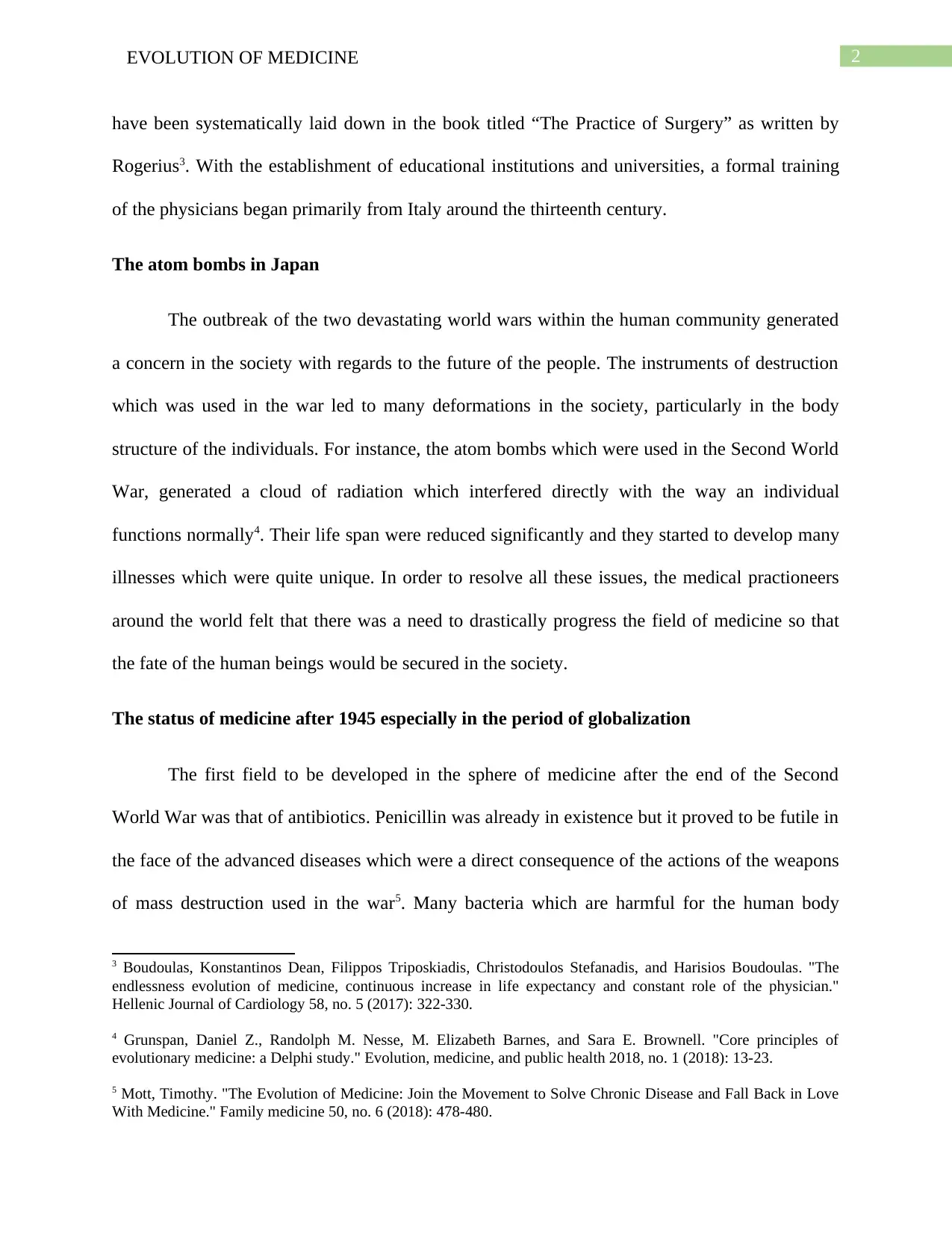
2EVOLUTION OF MEDICINE
have been systematically laid down in the book titled “The Practice of Surgery” as written by
Rogerius3. With the establishment of educational institutions and universities, a formal training
of the physicians began primarily from Italy around the thirteenth century.
The atom bombs in Japan
The outbreak of the two devastating world wars within the human community generated
a concern in the society with regards to the future of the people. The instruments of destruction
which was used in the war led to many deformations in the society, particularly in the body
structure of the individuals. For instance, the atom bombs which were used in the Second World
War, generated a cloud of radiation which interfered directly with the way an individual
functions normally4. Their life span were reduced significantly and they started to develop many
illnesses which were quite unique. In order to resolve all these issues, the medical practioneers
around the world felt that there was a need to drastically progress the field of medicine so that
the fate of the human beings would be secured in the society.
The status of medicine after 1945 especially in the period of globalization
The first field to be developed in the sphere of medicine after the end of the Second
World War was that of antibiotics. Penicillin was already in existence but it proved to be futile in
the face of the advanced diseases which were a direct consequence of the actions of the weapons
of mass destruction used in the war5. Many bacteria which are harmful for the human body
3 Boudoulas, Konstantinos Dean, Filippos Triposkiadis, Christodoulos Stefanadis, and Harisios Boudoulas. "The
endlessness evolution of medicine, continuous increase in life expectancy and constant role of the physician."
Hellenic Journal of Cardiology 58, no. 5 (2017): 322-330.
4 Grunspan, Daniel Z., Randolph M. Nesse, M. Elizabeth Barnes, and Sara E. Brownell. "Core principles of
evolutionary medicine: a Delphi study." Evolution, medicine, and public health 2018, no. 1 (2018): 13-23.
5 Mott, Timothy. "The Evolution of Medicine: Join the Movement to Solve Chronic Disease and Fall Back in Love
With Medicine." Family medicine 50, no. 6 (2018): 478-480.
have been systematically laid down in the book titled “The Practice of Surgery” as written by
Rogerius3. With the establishment of educational institutions and universities, a formal training
of the physicians began primarily from Italy around the thirteenth century.
The atom bombs in Japan
The outbreak of the two devastating world wars within the human community generated
a concern in the society with regards to the future of the people. The instruments of destruction
which was used in the war led to many deformations in the society, particularly in the body
structure of the individuals. For instance, the atom bombs which were used in the Second World
War, generated a cloud of radiation which interfered directly with the way an individual
functions normally4. Their life span were reduced significantly and they started to develop many
illnesses which were quite unique. In order to resolve all these issues, the medical practioneers
around the world felt that there was a need to drastically progress the field of medicine so that
the fate of the human beings would be secured in the society.
The status of medicine after 1945 especially in the period of globalization
The first field to be developed in the sphere of medicine after the end of the Second
World War was that of antibiotics. Penicillin was already in existence but it proved to be futile in
the face of the advanced diseases which were a direct consequence of the actions of the weapons
of mass destruction used in the war5. Many bacteria which are harmful for the human body
3 Boudoulas, Konstantinos Dean, Filippos Triposkiadis, Christodoulos Stefanadis, and Harisios Boudoulas. "The
endlessness evolution of medicine, continuous increase in life expectancy and constant role of the physician."
Hellenic Journal of Cardiology 58, no. 5 (2017): 322-330.
4 Grunspan, Daniel Z., Randolph M. Nesse, M. Elizabeth Barnes, and Sara E. Brownell. "Core principles of
evolutionary medicine: a Delphi study." Evolution, medicine, and public health 2018, no. 1 (2018): 13-23.
5 Mott, Timothy. "The Evolution of Medicine: Join the Movement to Solve Chronic Disease and Fall Back in Love
With Medicine." Family medicine 50, no. 6 (2018): 478-480.
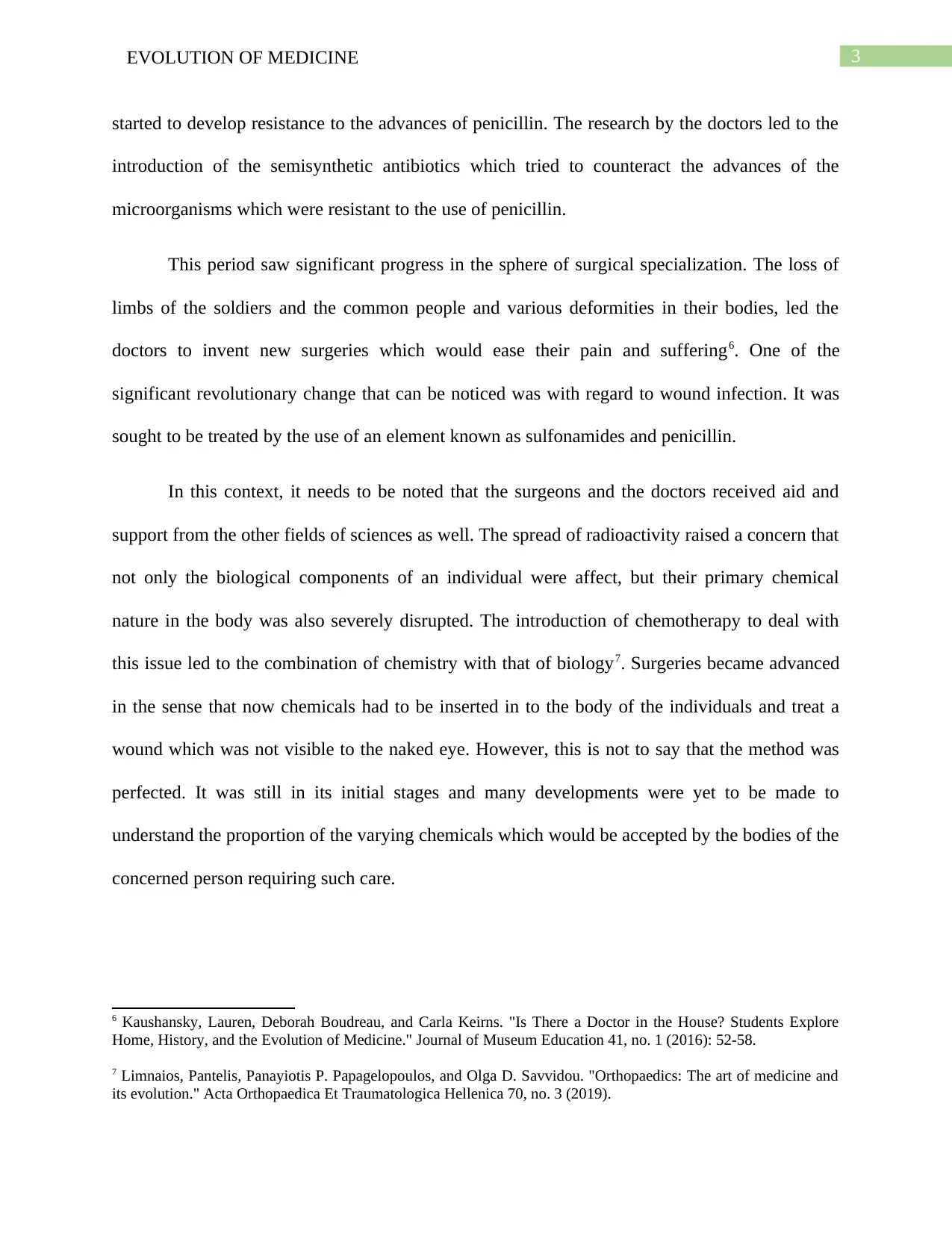
3EVOLUTION OF MEDICINE
started to develop resistance to the advances of penicillin. The research by the doctors led to the
introduction of the semisynthetic antibiotics which tried to counteract the advances of the
microorganisms which were resistant to the use of penicillin.
This period saw significant progress in the sphere of surgical specialization. The loss of
limbs of the soldiers and the common people and various deformities in their bodies, led the
doctors to invent new surgeries which would ease their pain and suffering6. One of the
significant revolutionary change that can be noticed was with regard to wound infection. It was
sought to be treated by the use of an element known as sulfonamides and penicillin.
In this context, it needs to be noted that the surgeons and the doctors received aid and
support from the other fields of sciences as well. The spread of radioactivity raised a concern that
not only the biological components of an individual were affect, but their primary chemical
nature in the body was also severely disrupted. The introduction of chemotherapy to deal with
this issue led to the combination of chemistry with that of biology7. Surgeries became advanced
in the sense that now chemicals had to be inserted in to the body of the individuals and treat a
wound which was not visible to the naked eye. However, this is not to say that the method was
perfected. It was still in its initial stages and many developments were yet to be made to
understand the proportion of the varying chemicals which would be accepted by the bodies of the
concerned person requiring such care.
6 Kaushansky, Lauren, Deborah Boudreau, and Carla Keirns. "Is There a Doctor in the House? Students Explore
Home, History, and the Evolution of Medicine." Journal of Museum Education 41, no. 1 (2016): 52-58.
7 Limnaios, Pantelis, Panayiotis P. Papagelopoulos, and Olga D. Savvidou. "Orthopaedics: The art of medicine and
its evolution." Acta Orthopaedica Et Traumatologica Hellenica 70, no. 3 (2019).
started to develop resistance to the advances of penicillin. The research by the doctors led to the
introduction of the semisynthetic antibiotics which tried to counteract the advances of the
microorganisms which were resistant to the use of penicillin.
This period saw significant progress in the sphere of surgical specialization. The loss of
limbs of the soldiers and the common people and various deformities in their bodies, led the
doctors to invent new surgeries which would ease their pain and suffering6. One of the
significant revolutionary change that can be noticed was with regard to wound infection. It was
sought to be treated by the use of an element known as sulfonamides and penicillin.
In this context, it needs to be noted that the surgeons and the doctors received aid and
support from the other fields of sciences as well. The spread of radioactivity raised a concern that
not only the biological components of an individual were affect, but their primary chemical
nature in the body was also severely disrupted. The introduction of chemotherapy to deal with
this issue led to the combination of chemistry with that of biology7. Surgeries became advanced
in the sense that now chemicals had to be inserted in to the body of the individuals and treat a
wound which was not visible to the naked eye. However, this is not to say that the method was
perfected. It was still in its initial stages and many developments were yet to be made to
understand the proportion of the varying chemicals which would be accepted by the bodies of the
concerned person requiring such care.
6 Kaushansky, Lauren, Deborah Boudreau, and Carla Keirns. "Is There a Doctor in the House? Students Explore
Home, History, and the Evolution of Medicine." Journal of Museum Education 41, no. 1 (2016): 52-58.
7 Limnaios, Pantelis, Panayiotis P. Papagelopoulos, and Olga D. Savvidou. "Orthopaedics: The art of medicine and
its evolution." Acta Orthopaedica Et Traumatologica Hellenica 70, no. 3 (2019).
Secure Best Marks with AI Grader
Need help grading? Try our AI Grader for instant feedback on your assignments.
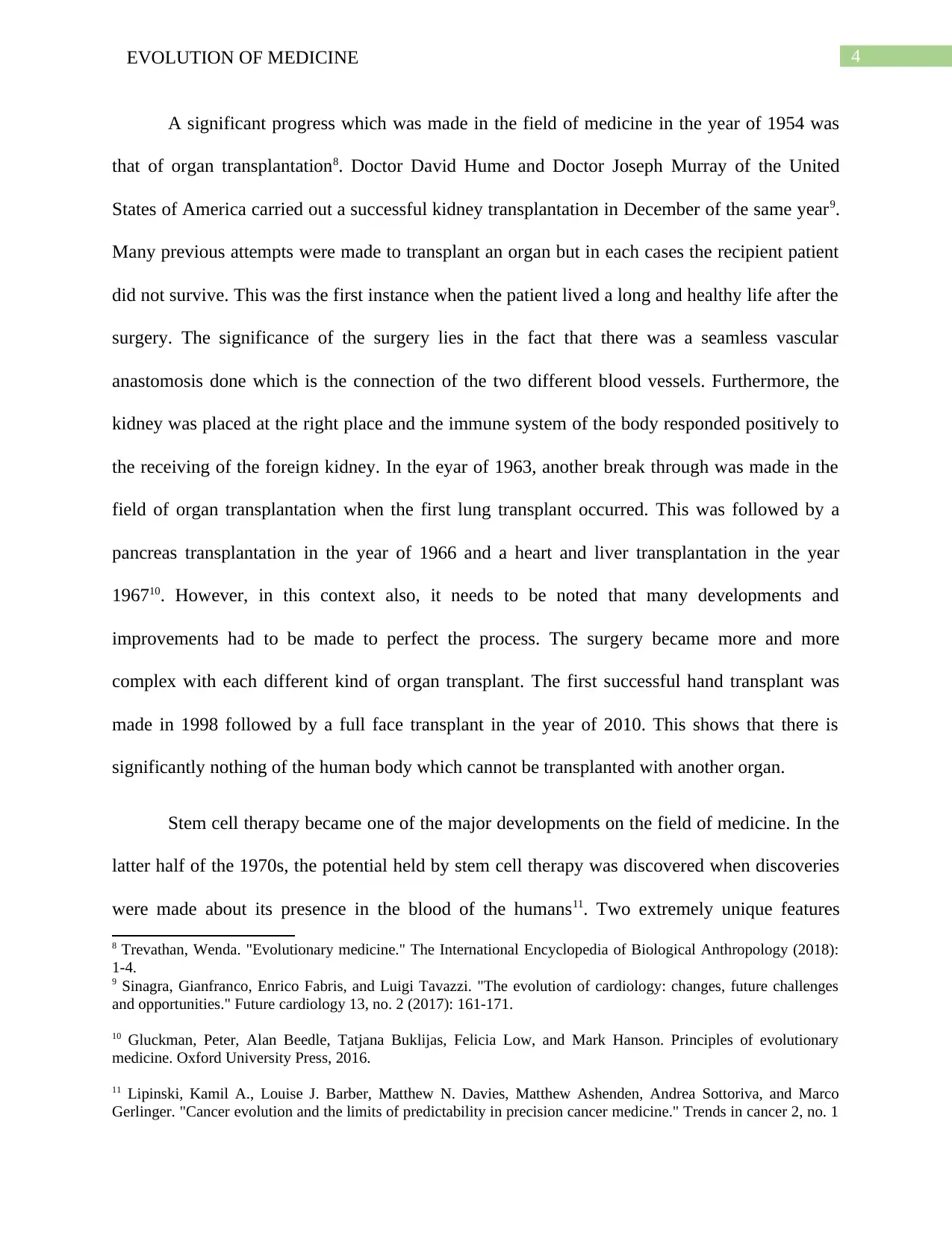
4EVOLUTION OF MEDICINE
A significant progress which was made in the field of medicine in the year of 1954 was
that of organ transplantation8. Doctor David Hume and Doctor Joseph Murray of the United
States of America carried out a successful kidney transplantation in December of the same year9.
Many previous attempts were made to transplant an organ but in each cases the recipient patient
did not survive. This was the first instance when the patient lived a long and healthy life after the
surgery. The significance of the surgery lies in the fact that there was a seamless vascular
anastomosis done which is the connection of the two different blood vessels. Furthermore, the
kidney was placed at the right place and the immune system of the body responded positively to
the receiving of the foreign kidney. In the eyar of 1963, another break through was made in the
field of organ transplantation when the first lung transplant occurred. This was followed by a
pancreas transplantation in the year of 1966 and a heart and liver transplantation in the year
196710. However, in this context also, it needs to be noted that many developments and
improvements had to be made to perfect the process. The surgery became more and more
complex with each different kind of organ transplant. The first successful hand transplant was
made in 1998 followed by a full face transplant in the year of 2010. This shows that there is
significantly nothing of the human body which cannot be transplanted with another organ.
Stem cell therapy became one of the major developments on the field of medicine. In the
latter half of the 1970s, the potential held by stem cell therapy was discovered when discoveries
were made about its presence in the blood of the humans11. Two extremely unique features
8 Trevathan, Wenda. "Evolutionary medicine." The International Encyclopedia of Biological Anthropology (2018):
1-4.
9 Sinagra, Gianfranco, Enrico Fabris, and Luigi Tavazzi. "The evolution of cardiology: changes, future challenges
and opportunities." Future cardiology 13, no. 2 (2017): 161-171.
10 Gluckman, Peter, Alan Beedle, Tatjana Buklijas, Felicia Low, and Mark Hanson. Principles of evolutionary
medicine. Oxford University Press, 2016.
11 Lipinski, Kamil A., Louise J. Barber, Matthew N. Davies, Matthew Ashenden, Andrea Sottoriva, and Marco
Gerlinger. "Cancer evolution and the limits of predictability in precision cancer medicine." Trends in cancer 2, no. 1
A significant progress which was made in the field of medicine in the year of 1954 was
that of organ transplantation8. Doctor David Hume and Doctor Joseph Murray of the United
States of America carried out a successful kidney transplantation in December of the same year9.
Many previous attempts were made to transplant an organ but in each cases the recipient patient
did not survive. This was the first instance when the patient lived a long and healthy life after the
surgery. The significance of the surgery lies in the fact that there was a seamless vascular
anastomosis done which is the connection of the two different blood vessels. Furthermore, the
kidney was placed at the right place and the immune system of the body responded positively to
the receiving of the foreign kidney. In the eyar of 1963, another break through was made in the
field of organ transplantation when the first lung transplant occurred. This was followed by a
pancreas transplantation in the year of 1966 and a heart and liver transplantation in the year
196710. However, in this context also, it needs to be noted that many developments and
improvements had to be made to perfect the process. The surgery became more and more
complex with each different kind of organ transplant. The first successful hand transplant was
made in 1998 followed by a full face transplant in the year of 2010. This shows that there is
significantly nothing of the human body which cannot be transplanted with another organ.
Stem cell therapy became one of the major developments on the field of medicine. In the
latter half of the 1970s, the potential held by stem cell therapy was discovered when discoveries
were made about its presence in the blood of the humans11. Two extremely unique features
8 Trevathan, Wenda. "Evolutionary medicine." The International Encyclopedia of Biological Anthropology (2018):
1-4.
9 Sinagra, Gianfranco, Enrico Fabris, and Luigi Tavazzi. "The evolution of cardiology: changes, future challenges
and opportunities." Future cardiology 13, no. 2 (2017): 161-171.
10 Gluckman, Peter, Alan Beedle, Tatjana Buklijas, Felicia Low, and Mark Hanson. Principles of evolutionary
medicine. Oxford University Press, 2016.
11 Lipinski, Kamil A., Louise J. Barber, Matthew N. Davies, Matthew Ashenden, Andrea Sottoriva, and Marco
Gerlinger. "Cancer evolution and the limits of predictability in precision cancer medicine." Trends in cancer 2, no. 1
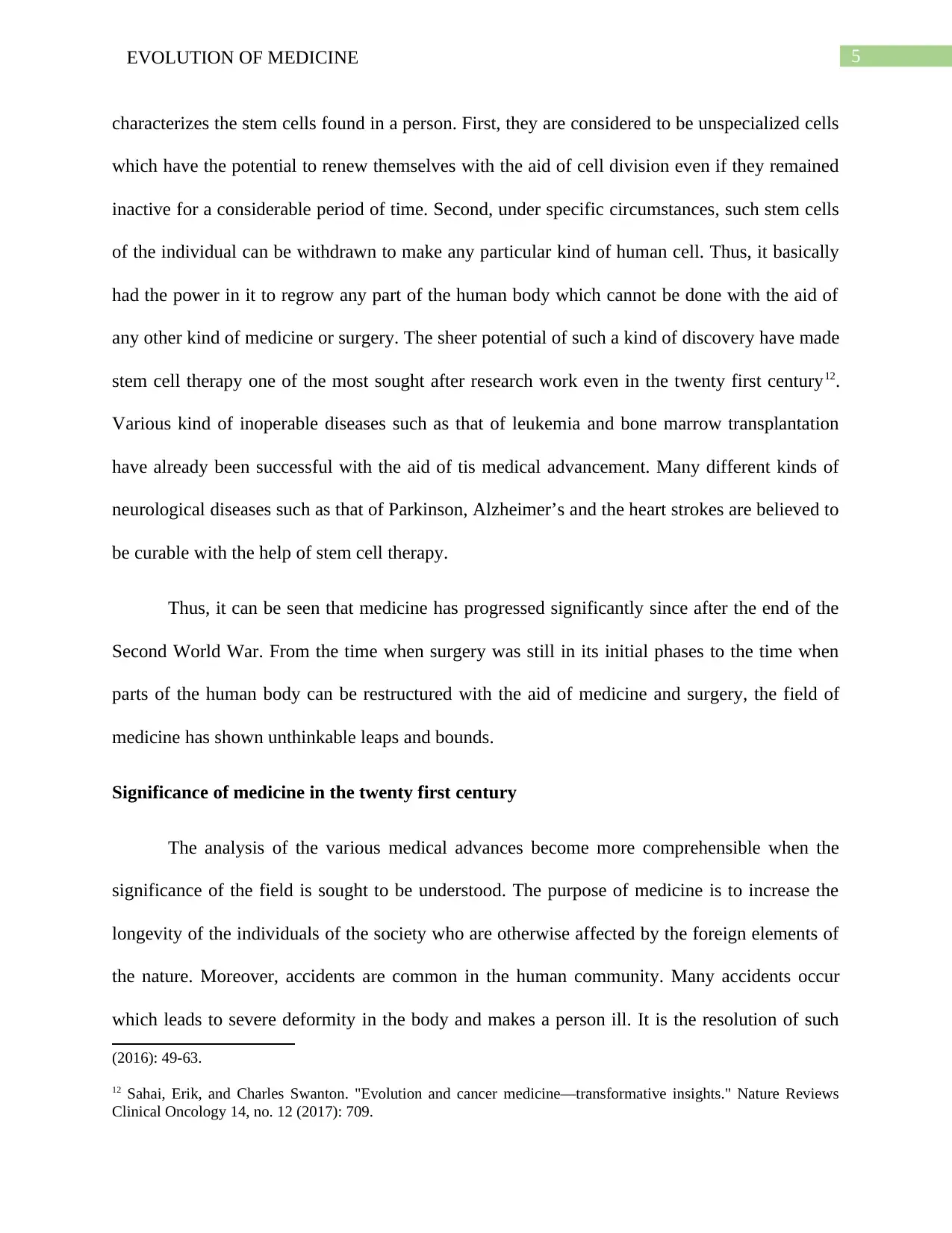
5EVOLUTION OF MEDICINE
characterizes the stem cells found in a person. First, they are considered to be unspecialized cells
which have the potential to renew themselves with the aid of cell division even if they remained
inactive for a considerable period of time. Second, under specific circumstances, such stem cells
of the individual can be withdrawn to make any particular kind of human cell. Thus, it basically
had the power in it to regrow any part of the human body which cannot be done with the aid of
any other kind of medicine or surgery. The sheer potential of such a kind of discovery have made
stem cell therapy one of the most sought after research work even in the twenty first century12.
Various kind of inoperable diseases such as that of leukemia and bone marrow transplantation
have already been successful with the aid of tis medical advancement. Many different kinds of
neurological diseases such as that of Parkinson, Alzheimer’s and the heart strokes are believed to
be curable with the help of stem cell therapy.
Thus, it can be seen that medicine has progressed significantly since after the end of the
Second World War. From the time when surgery was still in its initial phases to the time when
parts of the human body can be restructured with the aid of medicine and surgery, the field of
medicine has shown unthinkable leaps and bounds.
Significance of medicine in the twenty first century
The analysis of the various medical advances become more comprehensible when the
significance of the field is sought to be understood. The purpose of medicine is to increase the
longevity of the individuals of the society who are otherwise affected by the foreign elements of
the nature. Moreover, accidents are common in the human community. Many accidents occur
which leads to severe deformity in the body and makes a person ill. It is the resolution of such
(2016): 49-63.
12 Sahai, Erik, and Charles Swanton. "Evolution and cancer medicine—transformative insights." Nature Reviews
Clinical Oncology 14, no. 12 (2017): 709.
characterizes the stem cells found in a person. First, they are considered to be unspecialized cells
which have the potential to renew themselves with the aid of cell division even if they remained
inactive for a considerable period of time. Second, under specific circumstances, such stem cells
of the individual can be withdrawn to make any particular kind of human cell. Thus, it basically
had the power in it to regrow any part of the human body which cannot be done with the aid of
any other kind of medicine or surgery. The sheer potential of such a kind of discovery have made
stem cell therapy one of the most sought after research work even in the twenty first century12.
Various kind of inoperable diseases such as that of leukemia and bone marrow transplantation
have already been successful with the aid of tis medical advancement. Many different kinds of
neurological diseases such as that of Parkinson, Alzheimer’s and the heart strokes are believed to
be curable with the help of stem cell therapy.
Thus, it can be seen that medicine has progressed significantly since after the end of the
Second World War. From the time when surgery was still in its initial phases to the time when
parts of the human body can be restructured with the aid of medicine and surgery, the field of
medicine has shown unthinkable leaps and bounds.
Significance of medicine in the twenty first century
The analysis of the various medical advances become more comprehensible when the
significance of the field is sought to be understood. The purpose of medicine is to increase the
longevity of the individuals of the society who are otherwise affected by the foreign elements of
the nature. Moreover, accidents are common in the human community. Many accidents occur
which leads to severe deformity in the body and makes a person ill. It is the resolution of such
(2016): 49-63.
12 Sahai, Erik, and Charles Swanton. "Evolution and cancer medicine—transformative insights." Nature Reviews
Clinical Oncology 14, no. 12 (2017): 709.
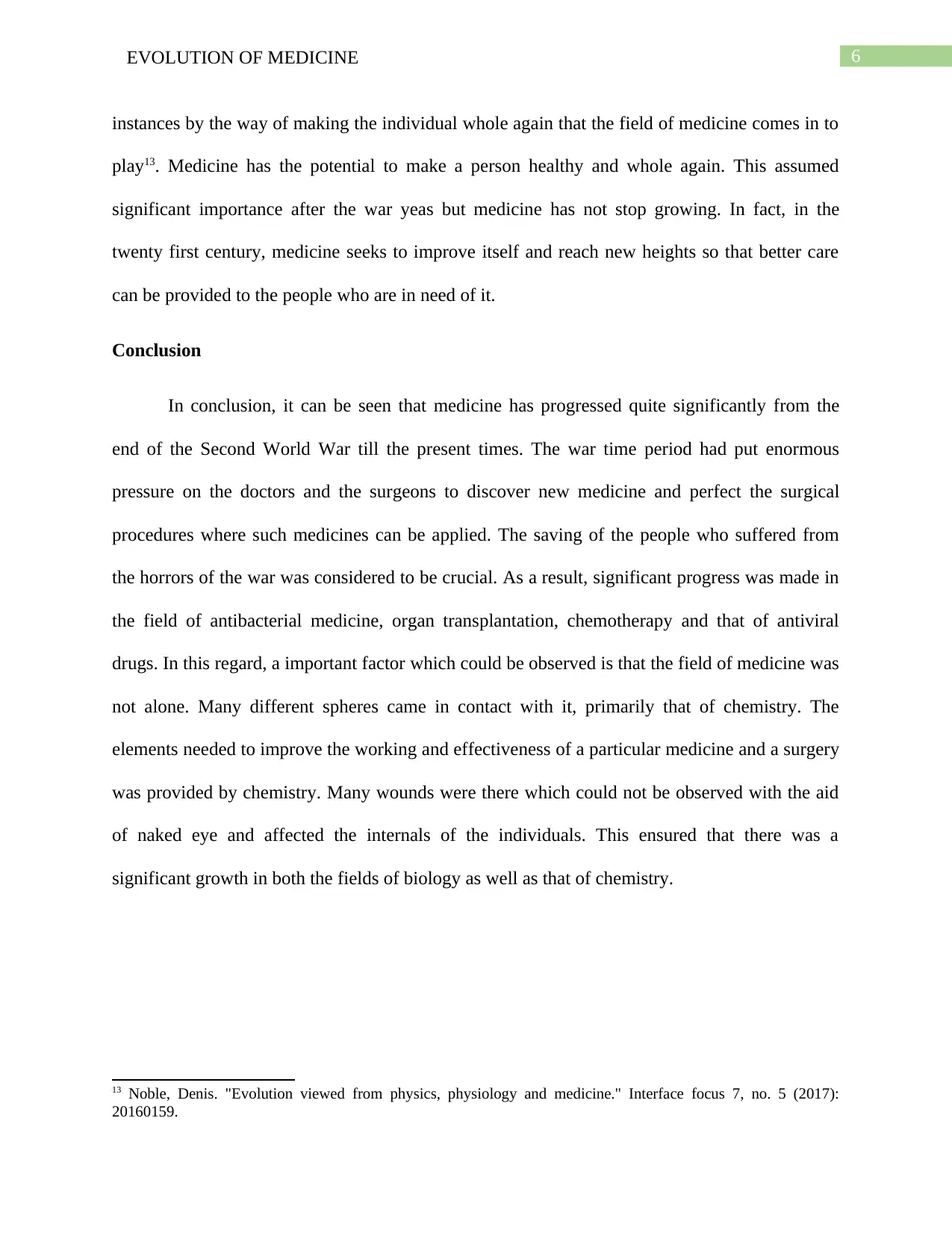
6EVOLUTION OF MEDICINE
instances by the way of making the individual whole again that the field of medicine comes in to
play13. Medicine has the potential to make a person healthy and whole again. This assumed
significant importance after the war yeas but medicine has not stop growing. In fact, in the
twenty first century, medicine seeks to improve itself and reach new heights so that better care
can be provided to the people who are in need of it.
Conclusion
In conclusion, it can be seen that medicine has progressed quite significantly from the
end of the Second World War till the present times. The war time period had put enormous
pressure on the doctors and the surgeons to discover new medicine and perfect the surgical
procedures where such medicines can be applied. The saving of the people who suffered from
the horrors of the war was considered to be crucial. As a result, significant progress was made in
the field of antibacterial medicine, organ transplantation, chemotherapy and that of antiviral
drugs. In this regard, a important factor which could be observed is that the field of medicine was
not alone. Many different spheres came in contact with it, primarily that of chemistry. The
elements needed to improve the working and effectiveness of a particular medicine and a surgery
was provided by chemistry. Many wounds were there which could not be observed with the aid
of naked eye and affected the internals of the individuals. This ensured that there was a
significant growth in both the fields of biology as well as that of chemistry.
13 Noble, Denis. "Evolution viewed from physics, physiology and medicine." Interface focus 7, no. 5 (2017):
20160159.
instances by the way of making the individual whole again that the field of medicine comes in to
play13. Medicine has the potential to make a person healthy and whole again. This assumed
significant importance after the war yeas but medicine has not stop growing. In fact, in the
twenty first century, medicine seeks to improve itself and reach new heights so that better care
can be provided to the people who are in need of it.
Conclusion
In conclusion, it can be seen that medicine has progressed quite significantly from the
end of the Second World War till the present times. The war time period had put enormous
pressure on the doctors and the surgeons to discover new medicine and perfect the surgical
procedures where such medicines can be applied. The saving of the people who suffered from
the horrors of the war was considered to be crucial. As a result, significant progress was made in
the field of antibacterial medicine, organ transplantation, chemotherapy and that of antiviral
drugs. In this regard, a important factor which could be observed is that the field of medicine was
not alone. Many different spheres came in contact with it, primarily that of chemistry. The
elements needed to improve the working and effectiveness of a particular medicine and a surgery
was provided by chemistry. Many wounds were there which could not be observed with the aid
of naked eye and affected the internals of the individuals. This ensured that there was a
significant growth in both the fields of biology as well as that of chemistry.
13 Noble, Denis. "Evolution viewed from physics, physiology and medicine." Interface focus 7, no. 5 (2017):
20160159.
Paraphrase This Document
Need a fresh take? Get an instant paraphrase of this document with our AI Paraphraser
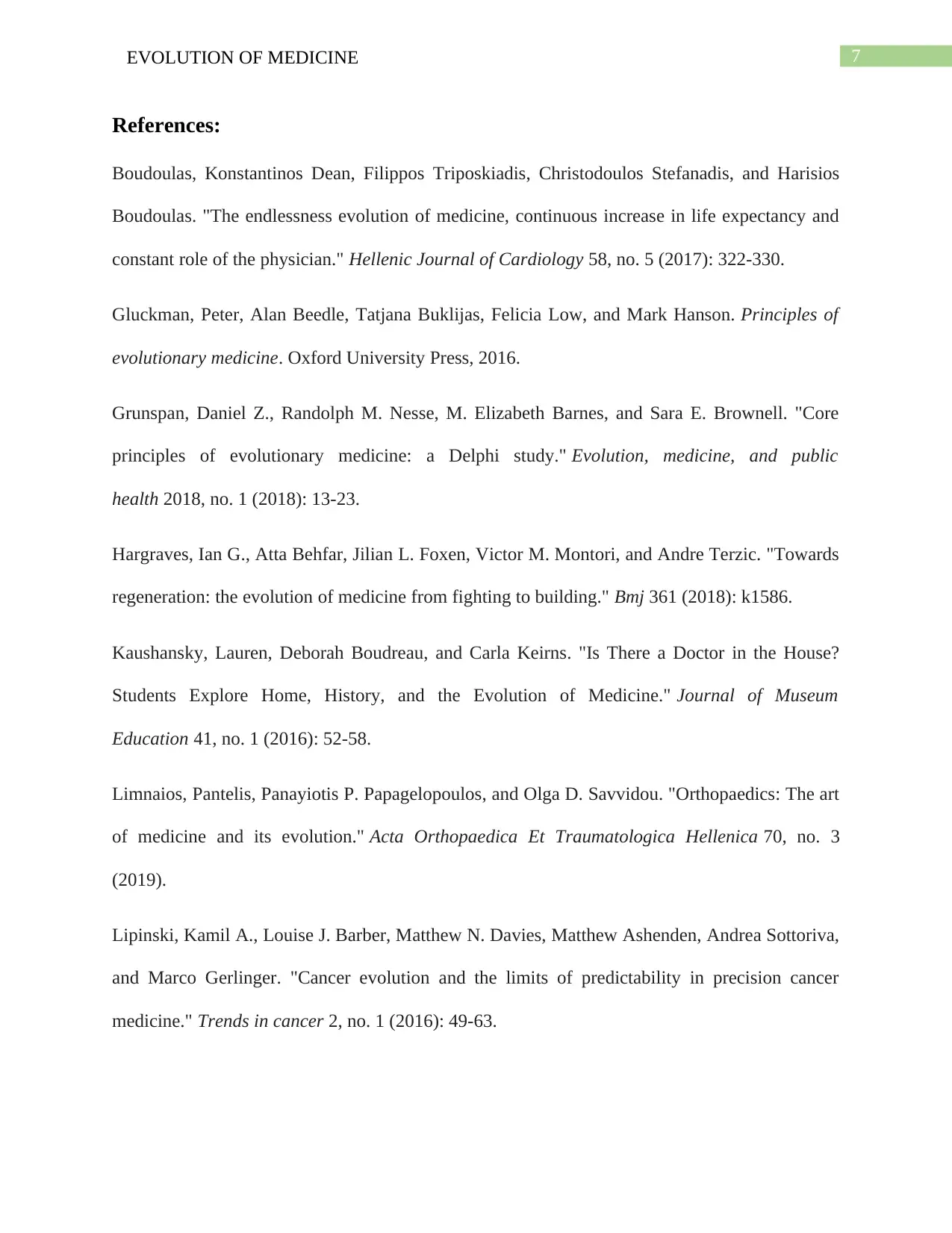
7EVOLUTION OF MEDICINE
References:
Boudoulas, Konstantinos Dean, Filippos Triposkiadis, Christodoulos Stefanadis, and Harisios
Boudoulas. "The endlessness evolution of medicine, continuous increase in life expectancy and
constant role of the physician." Hellenic Journal of Cardiology 58, no. 5 (2017): 322-330.
Gluckman, Peter, Alan Beedle, Tatjana Buklijas, Felicia Low, and Mark Hanson. Principles of
evolutionary medicine. Oxford University Press, 2016.
Grunspan, Daniel Z., Randolph M. Nesse, M. Elizabeth Barnes, and Sara E. Brownell. "Core
principles of evolutionary medicine: a Delphi study." Evolution, medicine, and public
health 2018, no. 1 (2018): 13-23.
Hargraves, Ian G., Atta Behfar, Jilian L. Foxen, Victor M. Montori, and Andre Terzic. "Towards
regeneration: the evolution of medicine from fighting to building." Bmj 361 (2018): k1586.
Kaushansky, Lauren, Deborah Boudreau, and Carla Keirns. "Is There a Doctor in the House?
Students Explore Home, History, and the Evolution of Medicine." Journal of Museum
Education 41, no. 1 (2016): 52-58.
Limnaios, Pantelis, Panayiotis P. Papagelopoulos, and Olga D. Savvidou. "Orthopaedics: The art
of medicine and its evolution." Acta Orthopaedica Et Traumatologica Hellenica 70, no. 3
(2019).
Lipinski, Kamil A., Louise J. Barber, Matthew N. Davies, Matthew Ashenden, Andrea Sottoriva,
and Marco Gerlinger. "Cancer evolution and the limits of predictability in precision cancer
medicine." Trends in cancer 2, no. 1 (2016): 49-63.
References:
Boudoulas, Konstantinos Dean, Filippos Triposkiadis, Christodoulos Stefanadis, and Harisios
Boudoulas. "The endlessness evolution of medicine, continuous increase in life expectancy and
constant role of the physician." Hellenic Journal of Cardiology 58, no. 5 (2017): 322-330.
Gluckman, Peter, Alan Beedle, Tatjana Buklijas, Felicia Low, and Mark Hanson. Principles of
evolutionary medicine. Oxford University Press, 2016.
Grunspan, Daniel Z., Randolph M. Nesse, M. Elizabeth Barnes, and Sara E. Brownell. "Core
principles of evolutionary medicine: a Delphi study." Evolution, medicine, and public
health 2018, no. 1 (2018): 13-23.
Hargraves, Ian G., Atta Behfar, Jilian L. Foxen, Victor M. Montori, and Andre Terzic. "Towards
regeneration: the evolution of medicine from fighting to building." Bmj 361 (2018): k1586.
Kaushansky, Lauren, Deborah Boudreau, and Carla Keirns. "Is There a Doctor in the House?
Students Explore Home, History, and the Evolution of Medicine." Journal of Museum
Education 41, no. 1 (2016): 52-58.
Limnaios, Pantelis, Panayiotis P. Papagelopoulos, and Olga D. Savvidou. "Orthopaedics: The art
of medicine and its evolution." Acta Orthopaedica Et Traumatologica Hellenica 70, no. 3
(2019).
Lipinski, Kamil A., Louise J. Barber, Matthew N. Davies, Matthew Ashenden, Andrea Sottoriva,
and Marco Gerlinger. "Cancer evolution and the limits of predictability in precision cancer
medicine." Trends in cancer 2, no. 1 (2016): 49-63.
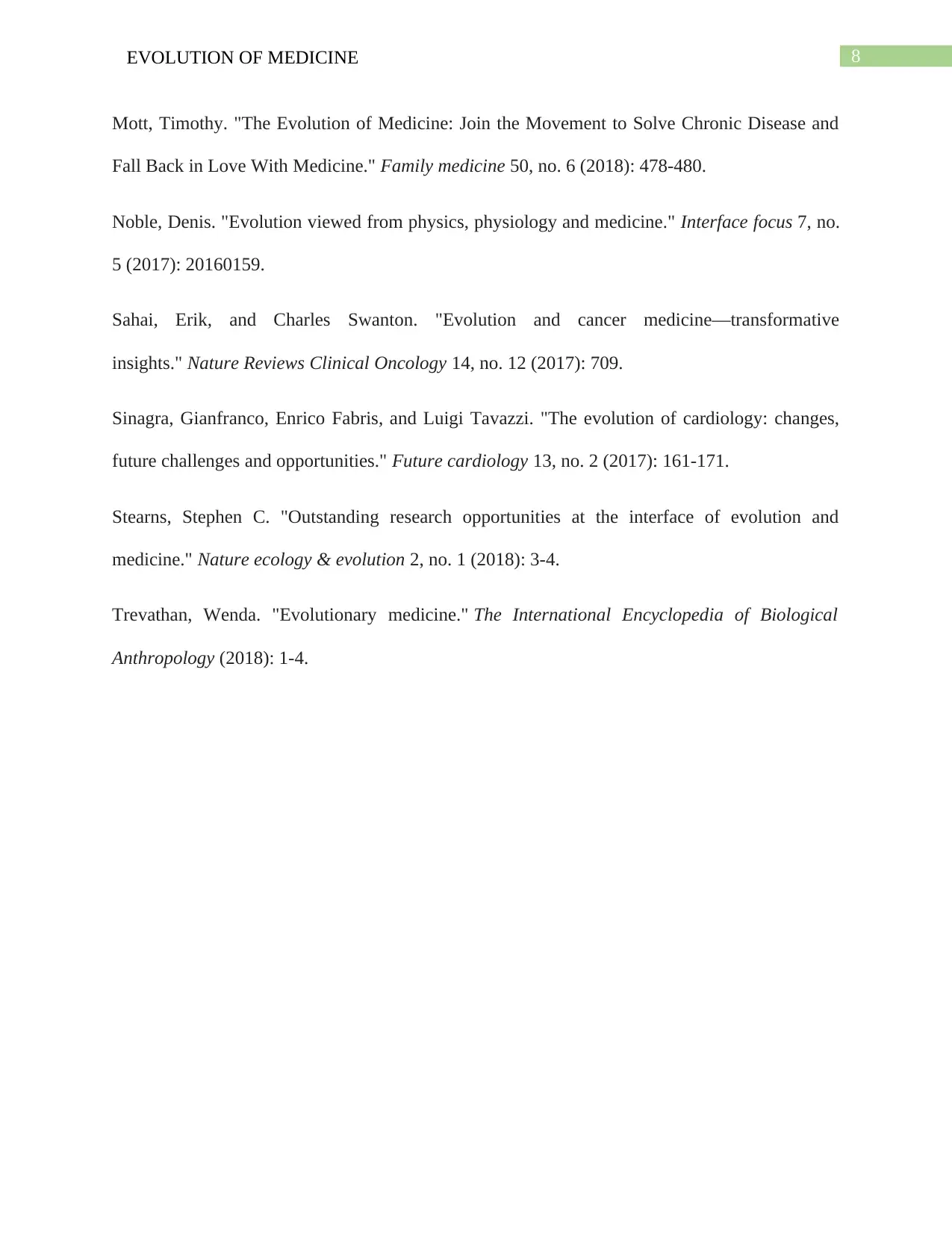
8EVOLUTION OF MEDICINE
Mott, Timothy. "The Evolution of Medicine: Join the Movement to Solve Chronic Disease and
Fall Back in Love With Medicine." Family medicine 50, no. 6 (2018): 478-480.
Noble, Denis. "Evolution viewed from physics, physiology and medicine." Interface focus 7, no.
5 (2017): 20160159.
Sahai, Erik, and Charles Swanton. "Evolution and cancer medicine—transformative
insights." Nature Reviews Clinical Oncology 14, no. 12 (2017): 709.
Sinagra, Gianfranco, Enrico Fabris, and Luigi Tavazzi. "The evolution of cardiology: changes,
future challenges and opportunities." Future cardiology 13, no. 2 (2017): 161-171.
Stearns, Stephen C. "Outstanding research opportunities at the interface of evolution and
medicine." Nature ecology & evolution 2, no. 1 (2018): 3-4.
Trevathan, Wenda. "Evolutionary medicine." The International Encyclopedia of Biological
Anthropology (2018): 1-4.
Mott, Timothy. "The Evolution of Medicine: Join the Movement to Solve Chronic Disease and
Fall Back in Love With Medicine." Family medicine 50, no. 6 (2018): 478-480.
Noble, Denis. "Evolution viewed from physics, physiology and medicine." Interface focus 7, no.
5 (2017): 20160159.
Sahai, Erik, and Charles Swanton. "Evolution and cancer medicine—transformative
insights." Nature Reviews Clinical Oncology 14, no. 12 (2017): 709.
Sinagra, Gianfranco, Enrico Fabris, and Luigi Tavazzi. "The evolution of cardiology: changes,
future challenges and opportunities." Future cardiology 13, no. 2 (2017): 161-171.
Stearns, Stephen C. "Outstanding research opportunities at the interface of evolution and
medicine." Nature ecology & evolution 2, no. 1 (2018): 3-4.
Trevathan, Wenda. "Evolutionary medicine." The International Encyclopedia of Biological
Anthropology (2018): 1-4.
1 out of 9
Your All-in-One AI-Powered Toolkit for Academic Success.
+13062052269
info@desklib.com
Available 24*7 on WhatsApp / Email
![[object Object]](/_next/static/media/star-bottom.7253800d.svg)
Unlock your academic potential
© 2024 | Zucol Services PVT LTD | All rights reserved.